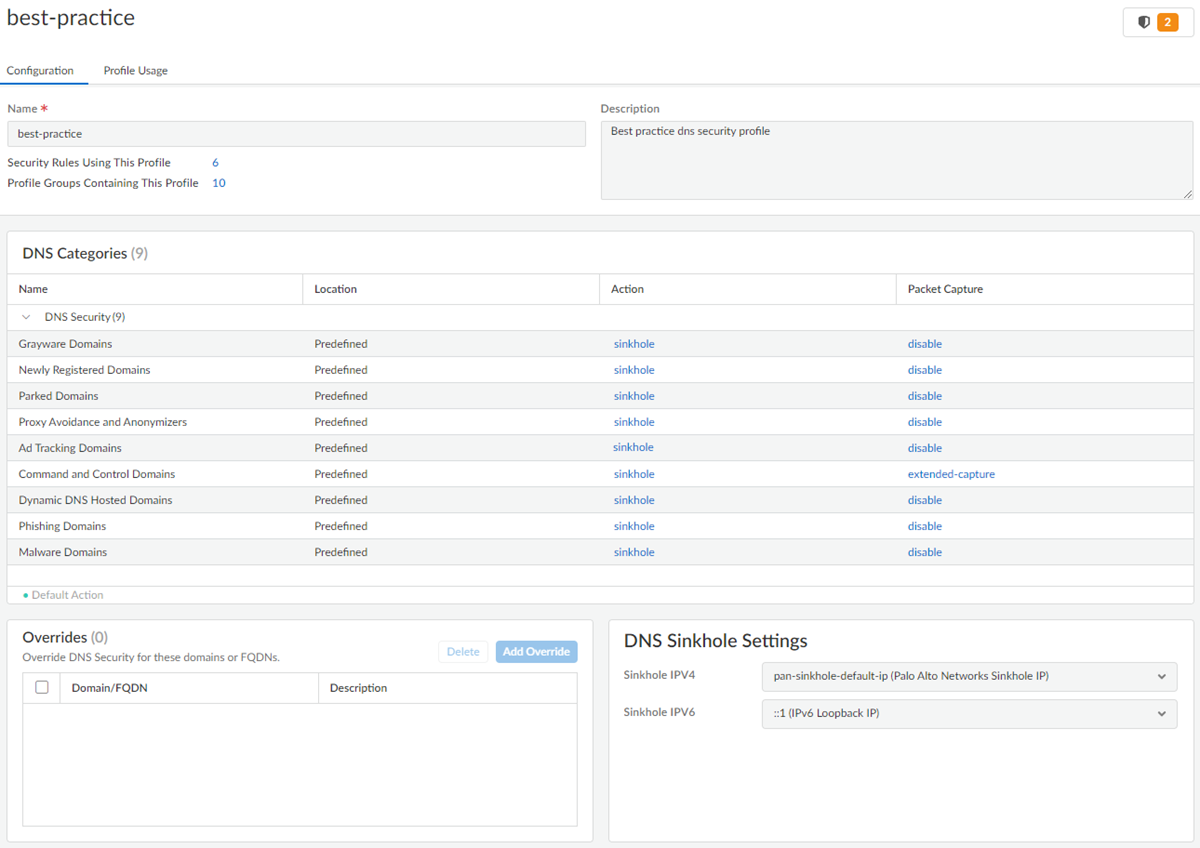Advanced DNS Security Powered by Precision AI®
Enable DNS Security (Strata Cloud Manager)
Table of Contents
Enable DNS Security (Strata Cloud Manager)
- Use the credentials associated with your Palo Alto Networks support account and log in to the Strata Cloud Manager on the hub.Verify that a DNS Security and a Threat Prevention (or Advanced Threat Prevention) license is active. Select ConfigurationNGFW and Prisma AccessOverview and click the license usage terms link in the License panel. You should see green check marks next to the following security services: Antivirus, Anti-Spyware, Vulnerability Protection, and DNS Security.Verify that the paloalto-dns-security App-ID in your security policy is configured to enable traffic from the DNS security cloud security service.If your firewall deployment routes your management traffic though an Internet-facing perimeter firewall configured to enforce App-ID security policies, you must allow the App-IDs on the perimeter firewall; failure to do so will prevent DNS security connectivity.Configure DNS Security signature policy settings to send malicious DNS queries to the defined sinkhole.If you use an external dynamic list as a domain allow list, it does not have precedence over the DNS Security domain policy actions. As a result, when there is a domain match to an entry in the EDL and a DNS Security domain category, the action specified under DNS Security is still applied, even when the EDL is explicitly configured with an action of Allow. If you want to add DNS domain exceptions, either configure an EDL with an Alert action or add them to the DNS Domain/FQDN Allow List located in the DNS Exceptions tab.
- Select ConfigurationNGFW and Prisma AccessSecurity ServicesDNS Security.Create or modify an existing DNS Security profile.Name the profile and, optionally, provide a description.In the DNS Categories section, beneath the DNS Security heading, there are individually configurable DNS signature sources, which allow you to define separate policy actions as well as the packet capture setting.Palo Alto Networks recommends using the default action setting for all signature sources to ensure optimum coverage as well as to assist with incidence response and remediation. For more information about the best practices for configuring your DNS Security settings, refer to Best Practices for Securing Your Network from Layer 4 and Layer 7 Evasions.
- Select an action to be taken when DNS lookups are made to known malware sites for the DNS Security signature source. The options are alert, allow, block, or sinkhole. Palo Alto Networks recommends setting the action to sinkhole.
- You can fully bypass DNS traffic inspection by configuring a policy action of Allow with a corresponding log severity of None for each DNS signature source.
- In the Packet Capture drop-down, select single-packet to capture the first packet of the session or extended-capture to set between 1-50 packets. You can then use the packet captures for further analysis.
In the DNS Sinkhole Settings section, verify that a valid Sinkhole address is present. For your convenience, the default setting (pan-sinkhole-default-ip) is set to access a Palo Alto Networks sinkhole server. Palo Alto Networks can automatically refresh this address through updates.Sinkhole forges a response to a DNS query for domains that match the DNS category configured for a sinkhole action to the specified sinkhole server, to assist in identifying compromised hosts. When the default sinkhole FQDN is used, the firewall sends the CNAME record as a response to the client, with the expectation that an internal DNS server will resolve the CNAME record, allowing malicious communications from the client to the configured sinkhole server to be logged and readily identifiable. However, if clients are in networks without an internal DNS server, or are using software or tools that cannot be properly resolve a CNAME into an A record response, the DNS request is dropped, resulting in incomplete traffic log details that are crucial for threat analysis. In these instances, you should use the following sinkhole IP address: (72.5.65.111).If you want to modify the Sinkhole IPv4 or Sinkhole IPv6 address to a local server on your network or to a loopback address, see Configure the Sinkhole IP Address to a Local Server on Your Network.![]() Click OK to save the DNS Security profile.Attach the DNS Security profile to a Security policy rule.Test that the policy action is enforced.
Click OK to save the DNS Security profile.Attach the DNS Security profile to a Security policy rule.Test that the policy action is enforced.- Access the DNS Security test domains to verify that the policy action for a given threat type is being enforced.To monitor the activity:
- View the activity logs and search for the URL Domain with a sinkholed action to view the log entries for the test domain you accessed.
Optional—Create a decryption policy rule to decrypt DNS-over-TLS / port 853 traffic. The decrypted DNS payload can then be processed using the DNS Security profile configuration containing your DNS policy settings. When DNS-over-TLS traffic is decrypted, the resulting DNS requests in the threat logs will appears as a conventional dns-base application with a source port of 853.For other monitoring options, see Monitor DNS Security Subscription Services

